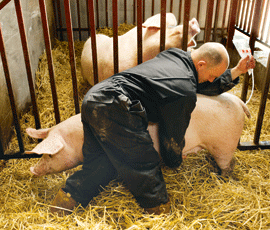Monthly ‘must do’s’: November 2011

1) Handle semen with care
As temperatures drop, pig producers need to pay special attention to semen handling, says Angela Cliff, BPEX knowledge transfer manager:
“BPEX AI Quality Standard semen is one of the most valuable commodities delivered to a pig unit. The challenge in winter is to prevent the semen chilling to below 15°C: the optimum storage temperature is 17°C with variation of no greater than 2°C.”
Some of the things producers can do are:
• Avoid overfull semen storage containers,
• Monitor storage temperature daily and
• Check the location of the storage container is not too cold.
2) Housing checks
DairyCo extension officer, Richard Davies, advises dairy producer to pay attention to the following before housing:
• Check there is an adequate feed space area at the feed fence. If your cows had callous marks on their necks or you noticed that your feed fence had shiny marks where cows had rubbed last winter then your feed barrier needs attention before the cows are indoors as it is likely to restrict access to feed.
• Before cows come indoors, find the time to check all gutters and downpipes to ensure they’re not bringing extra, unnecessary moisture into or around the buildings. High levels of moisture in cow livestock buildings will provide an ideal environment for bacteria and viruses that can cause diseases.
• Check water troughs are clean. Cows need easy access to an adequate clean water supply. Ideally water troughs should be located within 50 feet of feed areas and should provide 2-3″ of trough length a cow with a minimum water depth of 3″ at all times. Troughs should be 24″ to 32″ above ground height for black and white cows. Troughs should be situated to avoid dead ends so that less dominant animals still feel comfortable drinking.
3) Ration checklist
Keeping an eye on cattle can provide useful indications of how balanced a ration is, says EBLEX beef and sheep scientist Mary Vickers.
“Dung consistency reflects what is happening in the rumen. Very loose or hard dung may mean something needs to be changed.
“Most cattle that are not eating, sleeping or drinking should be chewing the cud, which indicates that there is sufficient fibre in the ration.”
For more information see Beef BRP Manual 7: Growing and Finishing Cattle for Better Returns.
4) Scanning sheep
Pregnancy scanning sheep at about 70 days helps identify barren ewes and those carrying singles and multiples, says Liz Genever, EBLEX beef and sheep scientist.
“Ewes can be grouped accordingly and their rations matched to their energy requirements, body condition and litter size.
“Scanning can help prevent disorders such as pregnancy toxaemia and simplifies fostering. Cull ewes can be sold.
For more information see Sheep BRP Manual 11: Target Ewe Fertility for Better Returns.
5) Test your ventilation
Good air flows in and out of cattle buildings can prevent disease and respiratory disorders, according to EBLEX’s Phil Hadley.
“Test the ventilation by using smoke pellets available from builders’ merchants,” he says.
“When the smoke clears within 2-3 minutes and does not linger in any corners, the ventilation is good. Test early on a muggy morning, when conditions tend to be at their worst.”
For more information see Beef BRP Manual 6: Improving beef housing for better returns.
6) Re-assess herd health management
Disease challenge has a big impact on pig productivity and the bottom line, says Helen Clarke, BPEX Veterinary Project Manager:
“Producers can learn more about how to make sure their system is set up for high health and profitable pig production during the first ‘BPEX Live’ online this month with vet Luke Minion, of Pipestone System in the USA.”
Register at www.2TS.org.uk and log-on to BPEX Live on Tuesday 8 November 2011, 7.00-8.00pm.
7) Get pigs in the box
Pig producers can improve profits by making sure more finished pigs meet the top grade specifications on their abattoir contract, says Lis Ravn, BPEX knowledge transfer manager.
Producers should focus on increasing the uniformity of slaughter pigs and aim for at least 85% of pigs in the optimum box for their contract.
See 2TS Action for Productivity factsheets 11: Increasing uniformity of finished pigs and 22: Improve your marketing return www.2TS.org.uk
MMD
See our previous monthly ‘must do’s’
